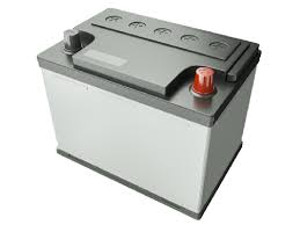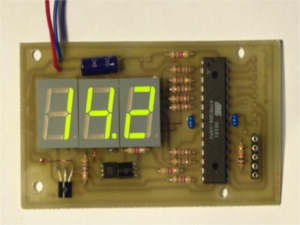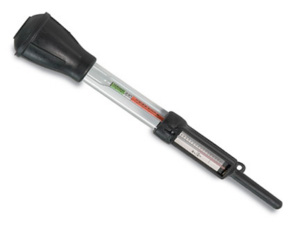
Battery Information & Testing
Cold Testing your RV Battery

The most common question I get asked while working in the store is questions about batteries.
RV house or coach batteries need to be true deep cycle batteries that are designed to provide a steady amount of current over a long period of time. Starting batteries and marine batteries should not be used in this application. True deep cycle batteries have much thicker plates and are designed to be deeply discharged and recharged over and over again. Many RVs use a single deep cycle battery. Deep cycle batteries are rated in amp hours. How many amps the battery can deliver for how many hours before the battery is discharged. If you enjoy dry camping, without utility hook-ups, you depend on your deep cycle battery(s) to take care of your 12-volt needs. You can purchase a deep cycle battery with a higher amp hour capacity that will last longer. The higher the amp hour capacity is the larger and heavier the battery is. If you have room for a larger battery and enjoy dry camping you may want to upgrade your deep cycle battery to one with a higher amp hour rating. If your RV is equipped with a marine RV battery you may want to upgrade to a true deep cycle battery.

There are basically three ways to check the condition of your RV batteries. You can check the monitor panel in the RV, you can measure the voltage with a digital voltmeter or you can check the specific gravity with a hydrometer.
When you check the condition of your battery using the monitor panel make sure the RV is not plugged into shore power. If it is you will get a false, fully charged reading. To get a more accurate reading of the battery’s condition check the monitor panel when the unit is not plugged in and turn a couple of over head lights on to place a small load on the battery. Measuring voltage with a voltmeter has its advantages.
If you have sealed batteries your only choice is to use a voltmeter, and measuring voltage can give you a quick picture of the batteries depth of discharge so you know when they need to be recharged.To measure the voltage you need a good digital voltmeter. Set the meter on DC voltage and connect the red lead to the positive terminal and the black lead to the negative terminal. A 12-volt battery that is charged should read 12.5 to 12.7 volts. Readings less than 12.5 indicate the battery state of charge is less than 70% and the battery needs to be charged. A 6-volt battery that is charged should read 6.25 to 6.37 volts. The battery should not be tested if it has been charged or discharged in the last 6 hours and preferably 24 hours.

The preferred method for testing the battery’s state of charge is to check the specific gravity reading of each cell. You can purchase a hydrometer at an auto parts store for about ten dollars. The electrolyte is a solution of acid and water so you need to wear safety glasses and gloves and avoid skin any contact. Remove the vent caps and check the electrolyte levels. There has to be enough electrolyte in the cells for the hydrometer to pick it up. If you have to add any water you’ll have to charge the battery and let it sit for at least six hours before testing. Fill and drain the hydrometer at least twice in each cell before taking a sample. Take the reading and record it then drain it back into the cell.Test all of the cells and replace the vent caps. Specific gravity readings for a charged battery should read between 1.235 and 1.277. Specific gravity readings below 1.235 indicate the battery state of charge is less than 70% and the battery needs to be charged. If there is a .050 or more difference in the specific gravity reading between the highest and lowest cell, you have a weak or dead cell in the battery.
Battery Life Expectancy
The life expectancy of your RV batteries depends on you. How they’re used, how well they’re maintained, how they’re discharged, how they’re re-charged, and how they are stored all contribute to a batteries life span. A battery cycle is one complete discharge from 100% down to about 50% and then re-charged back to 100%. One important factor to battery life is how deep the battery is cycled each time. If the battery is discharged to 50% everyday it will last twice as long as it would if it’s cycled to 80%. Keep this in mind when you consider a battery’s amp hour rating. The amp hour rating is really cut in half because you don’t want to completely discharge the battery before recharging it. The life expectancy depends on how soon a discharged battery is recharged. The sooner it is recharged the better.
What does all of this mean to you?
That depends on how you use your RV. If most of your camping is done where you’re plugged into an electrical source then your main concern is just too properly maintain your deep cycle batteries. But if you really like to get away from it all and you do some serious dry-camping you’ll want the highest amp hour capacities you can fit on your RV. Deep cycle batteries come in all different sizes. Some are designated by group size, like Group 24, 27 and 31. Basically the larger the battery the more amp hours you get. Depending on your needs and the amount of space you have available, there are several options when it comes to batteries. You can use one 12-volt Group 24 deep cycle battery that provides 70 to 85 amp hours or you can use two or more 12-volt batteries wired in parallel. Parallel wiring increases amp hours but not voltage. If you have the room you can do what a lot of RVers do and switch from the standard 12-volt batteries to two of the larger 6-volt golf cart batteries. These pairs of 6-volt batteries need to be wired in series to produce the required 12-volts. Series wiring increases voltage but not amp hours. If this still doesn’t satisfy your requirements you can build larger battery banks using four 6-volt batteries wired in series/parallel that will give you 12-volts and double your AH capacity.
contact us

